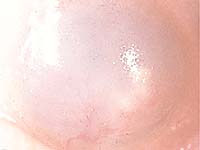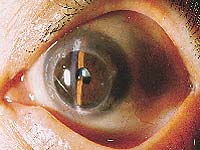Lyophilized human amniotic membrane 'patching' for ocular surface disorders
The human amniotic membrane promotes healing of the lesion.
When the ocular surface is covered with a human amniotic membrane, the healing process is promoted, and the pathological process is suppressed. Several methods have been reported for the preservation of the amniotic membrane, such as fresh, deep-frozen or media preserved in glycerol or propylene glycol and Optisol GS (Bausch & Lomb; Tampa, Fla.).
The lyophilized human amniotic membrane technique used by the Sri Lanka International Model Tissue Bank in Colombo is simple. A lyophilized amniotic membrane is mounted on a blue paper, with the amnion side facing the paper. There seems to be no consensus which side (amnion or chorion side) should face the ocular surface, because it is not expected that the membrane is organized with ocular surface after surgical patching. The lyophilized amniotic membrane composes a 20 µm to 30 µm thick by 12 cm by 20 cm wide sheet. When it is dried, the sheet appears as a white membrane. Once the sheet is wet, it again becomes translucent. We can get 240 pieces from a single amnion sheet.
Donor membranes
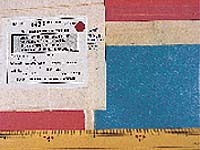 ---Lyophilized amniotic membrane used by the Sri Lanka International Model Tissue Bank.
---Lyophilized amniotic membrane used by the Sri Lanka International Model Tissue Bank.
Amniotic membranes are obtained from patients undergoing Cesarean sections in a maternity hospital. The donor is tested for HIV 1 & 2, hepatitis B and VDRL (TPHA), and the membrane is sterilized with radiation. The membrane can be preserved for a long period at room temperature as effectively as in other methods.
Pterygia
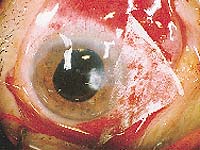 ---Amniotic membrane patched just after the excision of pterygium.
---Amniotic membrane patched just after the excision of pterygium.
Sixteen eyes with pterygia from 13 patients, 12 eyes from 12 patients who have undergone keratoplasty, five eyes from four patients with recurrent corneal erosion, two eyes with advanced herpetic stromal keratitis from two patients and one with carcinoma in situ of the cornea and conjunctiva all were patched with lyophilized amniotic membrane. In all cases, the amniotic membrane dissolved in 2 to 3 weeks, and the ocular surface appeared to be restored when the membrane dissolved. Note that the term “patching” rather than transplantating is used because the amnion is dissolved after 2 to 3 weeks and is not organized and retained on the ocular surface.
Of those with pterygia, three were recurrent pterygia, and the rest were thick and markedly vascularized primary pterygia. The pterygia were excised and patched with lyophilized amniotic membrane. Three eyes of the 16 developed recurrence in 1 year, but the recurrent pterygia were small, did not progress and hence did not require reoperation. The recurrence occurred in early cases in which only the scleral bed was patched, leaving the cornea and the sclera on both sides of the limbus exposed. After the surgical technique was changed to include the juxtalimbal peripheral cornea, none of the cases experienced recurrence. By comparison, in 31 eyes, including four eyes of recurrent pterygia that were excised with the same technique and by the same surgeon before amniotic membrane was introduced, recurrence occurred in 10 eyes out of 31 eyes, and some of them required reoperation.
Keratoplasty
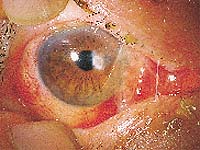 ---The same case at one day postop.
---The same case at one day postop.
In keratoplasty, the whole cornea and the bulbar conjunctiva were patched with the amniotic membrane at the completion of the surgery. Because the amniotic membrane becomes translucent when it is wet, the graft is visible through the membrane by the slit lamp. In all cases, when the amniotic membrane is dissolved, the graft epithelium appeared to be clear, and no sign of stromal edema was seen.
The Descemet's fold of the grafts also was less than with the cases prior to the introduction of the use of the amniotic membrane.
Recurrent corneal erosion
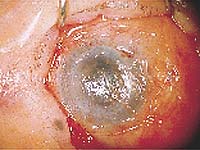 ---Penetrating keratoplasty covered by amniotic membrane.
---Penetrating keratoplasty covered by amniotic membrane.
In recurrent corneal erosion, a cornea-sized piece of amniotic membrane was patched over the cornea and covered by a bandage contact lens.
After 2 to 3 weeks, when the amniotic membrane had dissolved and the contact lens was removed, the epithelialization was had been completed in all cases.
Advanced herpetic stromal keratitis
 ---The same case after 3 weeks.
---The same case after 3 weeks.
In both eyes with advanced herpetic stromal keratitis, the entire cornea was milky white, and the eyes were inflamed. With amniotic membrane patching, the inflammation subsided in both eyes but corneal opacity was reduced in only one eye and vision improved to 0.4 (20/50).
In the other eye, the inflammation subsided, but the corneal opacity remained; however, when keratoplasty with amniotic membrane patching was subsequently performed, a clear graft was then achieved and vision was restored to 0.3 (20/70) with the presence of cataract.
Carcinoma in situ of the cornea
In the case of carcinoma in situ of the cornea and the conjunctiva, which is a locally malignant neoplasm, the corneal lesion was removed by keratoplasty. But again, the neoplasm recurred over the corneal graft and the bulbar conjunctiva.
After scraping of the neoplasm and application of mitomycin C, amniotic membrane patching was performed. After 1 year of follow-up, there was no recurrence.
|
|
|
|
|
|
The Cornea/External Disease Section Editor comments:
In this article the author presents a group of cases in which amnion “patching” is applicable to prevent pterygium recurrence, to stabilize recurrent erosion, to improve recovery of keratoplasty and to suppress inflammation in herpetic interstitial keratitis.
These applications and results are quite similar to the published experiences of many other authors, and although we are perhaps in a phase of amnion overutilization, amnion grafting is, thus far, seemingly without added risk of complication. It is inevitable that until its indications are more rigorously defined, its use will be and should be broadly extended.
Nonetheless, in situations of routine keratoplasty or epithelial erosion, it is not clear why amnion might be favored over conventional modalities.
More positively, however, and consistent with my own experience as well, amnion membrane transplantation is definitely a useful adjunct for both management of persistent epithelial defects, which are resistant to conventional therapeutic strategies, and of limbal stem cell transplantation (both autografts and allografts) for ocular surface rehabilitation.
Finally, as the amnion from the Sri Lanka Model Tissue Bank is most surely not available in the United States it should be noted that human preserved amnion is available in the United States from Tissue Banks International in Baltimore and from BioTissue in Miami.
Kenneth R. Kenyon, MD
Boston
For Your Information:
- Akira Momose, MD, can be reached at 1-100 Umeda Kiryu Gunma Japan 376-06; 81-277-32-1010; fax: 81-277-32-2216.



